 Notes: The first official CK&P reference to a station near the northern end of Bassenthwaite Lake was in 1861 to be at the most convenient position where the railway passed Smithy Green. At a Works Committee meeting on 10 November 1862 it was decided that the site of the station and mineral depot would be on the north side of the line with a siding for timber on the south side, and that a level crossing, rather than bridge, should be provided for the line to cross the turnpike road if the trustees were content. In November 1863 the CK&P Works Committee opened tenders which had been invited for the construction of stationmasters’ houses, and this included a house at ‘Piel Wyke’ station; the earliest OS maps indicate that this was the name of a hamlet about ¼-mile south of the station. On 2 December 1863 the contract was awarded to Bolton & Graham to construct Piel Wyke stationmaster’s house for £333. A Board meeting on 4 May 1864 decided on names for the stations, and this one was to be known as Bassenthwaite Lake. It seems that the Ordnance Survey was not informed that the station was to be called Bassenthwaite Lake as it was named Peelwyke on the 1:2,500 map published close to the date of opening of the line and station in 1865. In later OS maps the hamlet was no longer named, only the Pheasant Inn within it. By the end of the century the maps showed the correct name of the station. Local people usually shortened the name to ‘Bass Lake’. Notes: The first official CK&P reference to a station near the northern end of Bassenthwaite Lake was in 1861 to be at the most convenient position where the railway passed Smithy Green. At a Works Committee meeting on 10 November 1862 it was decided that the site of the station and mineral depot would be on the north side of the line with a siding for timber on the south side, and that a level crossing, rather than bridge, should be provided for the line to cross the turnpike road if the trustees were content. In November 1863 the CK&P Works Committee opened tenders which had been invited for the construction of stationmasters’ houses, and this included a house at ‘Piel Wyke’ station; the earliest OS maps indicate that this was the name of a hamlet about ¼-mile south of the station. On 2 December 1863 the contract was awarded to Bolton & Graham to construct Piel Wyke stationmaster’s house for £333. A Board meeting on 4 May 1864 decided on names for the stations, and this one was to be known as Bassenthwaite Lake. It seems that the Ordnance Survey was not informed that the station was to be called Bassenthwaite Lake as it was named Peelwyke on the 1:2,500 map published close to the date of opening of the line and station in 1865. In later OS maps the hamlet was no longer named, only the Pheasant Inn within it. By the end of the century the maps showed the correct name of the station. Local people usually shortened the name to ‘Bass Lake’.

Bassenthwaite Lake station stood immediately east of the level crossing on the Keswick – Cockermouth road. From its opening on 2 January 1865 it was a crossing place with two lines, each with a passenger platform. The main facilities were on the down (south) side. The single-storey stone building which contained the booking office, general waiting room and ladies’ room, was similar in size and layout to those at Penruddock, Troutbeck, Braithwaite and Embleton stations but more elaborate in design, having a gable over the office which projected onto the platform, rather than a continuation of the slope of the roof, and fancy bargeboards with decorative cresting on the roof. Attached to the south-eastern end of the building were a gents’ toilet and a store.
 In 1910 the booking office section was extended south-westwards to provide space for a Post Office; the style of the extension was sympathetic to the existing building, of stone construction under a gabled slate roof. Later, the attractive bargeboards were replaced with plain ones and the cresting was removed. To the east of this building a pair of two-storey cottages under a half-hipped roof was erected sometime after the station opened to accommodate the two signalmen and their families; the cottages were of stone construction but were rendered, presumably at a later date. The handsome two-storey stone station house, also with half-hipped roof, stood to the west, close to the level crossing. By contrast the only structure on the up platform was an undistinguished pent-roofed timber shed with chimneystacks at each end serving the fireplaces in the waiting and porters’ rooms. In 1874 a signal box of brick and timber construction, under a hipped roof, opened west of the up platform, adjacent to the level crossing. In 1910 the booking office section was extended south-westwards to provide space for a Post Office; the style of the extension was sympathetic to the existing building, of stone construction under a gabled slate roof. Later, the attractive bargeboards were replaced with plain ones and the cresting was removed. To the east of this building a pair of two-storey cottages under a half-hipped roof was erected sometime after the station opened to accommodate the two signalmen and their families; the cottages were of stone construction but were rendered, presumably at a later date. The handsome two-storey stone station house, also with half-hipped roof, stood to the west, close to the level crossing. By contrast the only structure on the up platform was an undistinguished pent-roofed timber shed with chimneystacks at each end serving the fireplaces in the waiting and porters’ rooms. In 1874 a signal box of brick and timber construction, under a hipped roof, opened west of the up platform, adjacent to the level crossing.
Samuel McKenzie was the first stationmaster. In 1867 he was succeeded by John Scott, who in turn was replaced by William Reay in 1872 and he held the post until 1876. In 1879 Thomas Allison was appointed.
Up trains: weekdays
August 1887 |
Destination |
Down trains: weekdays |
Destination |
7.07am |
Penrith |
8.14am Ø |
Cockermouth |
9.28am |
Penrith |
9.29am |
Workington |
11.30am |
Penrith |
11.01am |
Workington |
3.52pm |
Penrith |
2.56pm |
Workington |
6.17pm |
Penrith |
6.17pm |
Cockermouth |
- |
- |
7.00pm |
Workington |
- |
- |
8.46pm |
Workington |
Up trains: Sunday |
Destination |
Down trains: Sunday |
Destination |
9.47am |
Penrith |
8.06am |
Workington |
6.27pm |
Penrith |
7.06pm |
Workington |
Ø Goods and passenger train; punctuality not guaranteed
Originally the crossing loop was entirely to the east of the road crossing, but c1899 it was extended westwards over the level crossing as well as eastwards. The goods department was served by four sidings behind the up platform. The most northerly siding ended at three coal cells; cattle, timber and sundry other goods were dealt with and a small shed was provided.
In June 1907 oil lighting at Bassenthwaite Lake station gave way to acetylene gas, following its installation at several other minor stations on the CK&P. It was unusual for minor country stations to be gas-lit.
 It seems that from February 1910 the stationmaster took on the additional responsibility of Sub-Postmaster, although the 1900 OS map already identifies a Post Office in the building. As noted above, the station building was extended to accommodate this new function. The stationmaster from 1908-10 was John Blackburn and J W Ewart took on this role (as well as that of Sub-Postmaster) from 1910 until 1921. It seems that from February 1910 the stationmaster took on the additional responsibility of Sub-Postmaster, although the 1900 OS map already identifies a Post Office in the building. As noted above, the station building was extended to accommodate this new function. The stationmaster from 1908-10 was John Blackburn and J W Ewart took on this role (as well as that of Sub-Postmaster) from 1910 until 1921.
Up trains: weekdays
June 1920 |
Destination |
Down trains: weekdays |
Destination |
7.21am |
Penrith |
8.32am |
Workington |
9.06am |
Penrith |
10.00am |
Cockermouth |
11.32am |
Penrith |
10.56am |
Workington |
2.46pm |
Penrith |
2.15pm |
Workington |
6.12pm |
Penrith |
3.58pm |
Workington |
7.21pm |
Penrith |
7.25pm |
Workington |
- |
- |
9.27pm |
Workington |
No Sunday service
Bassenthwaite Lake station was attractively situated, with the bulk of Skiddaw providing a scenic backdrop to the south-east. The delights of the site were enhanced by the station garden. From Edwardian times until 1921 the CK&P gardener was James Shrives, and Bowtell (1989) remarks that he made this station his speciality. In the 1920s the Porter, Frank Bragg, was also a keen gardener.
 In January 1923 the station became part of the new London, Midland & Scottish Railway (LMS). At this time the stationmaster was Joseph Todhunter, who had been appointed in 1921. He held the post until 1933, and his successors were a Mr Grimley and Sam Whelan. The station changed little in LMS days, but it is thought that new nameboards were installed in this era. Camping coaches made their appearance, offering inexpensive accommodation for holidaymakers (who arrived and departed by train). Before 1939 the coaches were delivered to the station in spring and were removed for maintenance and storage in the winter. While they were in place at the station the siding upon which they stood was disconnected. In January 1923 the station became part of the new London, Midland & Scottish Railway (LMS). At this time the stationmaster was Joseph Todhunter, who had been appointed in 1921. He held the post until 1933, and his successors were a Mr Grimley and Sam Whelan. The station changed little in LMS days, but it is thought that new nameboards were installed in this era. Camping coaches made their appearance, offering inexpensive accommodation for holidaymakers (who arrived and departed by train). Before 1939 the coaches were delivered to the station in spring and were removed for maintenance and storage in the winter. While they were in place at the station the siding upon which they stood was disconnected.
Up trains: weekdays
6 May to 6 Oct 1946 |
Destination |
Down trains: weekdays |
Destination |
7.47am |
Penrith |
8.38am |
Workington |
8.40am SX ¶ |
Penrith |
11.20am † |
Workington |
9.14am MFSO |
London Euston |
12.30pm ‖ |
Workington |
10.40am SO § |
Liverpool Exchange |
1.35pm SO |
Workington |
11.46am ‡ |
Penrith |
2.31pm # |
Workington |
12.37pm SO |
Keswick |
3.57pm SO ++ |
Cockermouth |
2.57pm SX |
Penrith |
6.07pm SX |
Workington |
6.06pm |
Penrith |
6.57pm MFSO |
Workington |
6.56pm |
Penrith |
7.40pm SO |
Workington |
- |
- |
9.18pm |
Workington |
No Sunday service
SX Saturday excepted SO Saturday only MFSO Monday, Friday and Saturday only
‡ 6 minutes later on Monday, Friday and Saturday
† 8 minutes later on Monday, Friday and Saturday
‖ 7 minutes later on Tuesday, Wednesday and Thursday
¶ From 8 June ++ 15 June to 21 September # 18 May to 28 September
§ 22 June to 14 September
 In January 1948 at nationalisation Bassenthwaite Lake station became part of the new British Railways (BR) London Midland Region (LM). Some rationalisation of the goods yard took place in 1951 when two of the sidings were removed. The former CK&P saw the introduction of diesel multiple units in early January 1955 which gradually replaced steam-hauled passenger trains. In the summer 1956 timetable (below) Sunday trains were introduced; they did not serve all intermediate stations but did call at Bassenthwaite Lake. In January 1948 at nationalisation Bassenthwaite Lake station became part of the new British Railways (BR) London Midland Region (LM). Some rationalisation of the goods yard took place in 1951 when two of the sidings were removed. The former CK&P saw the introduction of diesel multiple units in early January 1955 which gradually replaced steam-hauled passenger trains. In the summer 1956 timetable (below) Sunday trains were introduced; they did not serve all intermediate stations but did call at Bassenthwaite Lake.
Up trains: weekdays
11 Jun – 16 Sep 1956 |
Destination |
Down trains: weekdays |
Destination |
7.35am |
Carlisle |
8.07am |
Workington |
8.39am SO* |
Crewe |
11.04am |
Workington |
9.11am # |
London Euston |
12.31pm |
Workington |
10.20am |
Carlisle ‡ |
2.21pm |
Workington |
12.05pm |
Penrith |
4.00pm SX |
Workington |
12.54pm |
Carlisle |
4.26pm SO |
Workington |
1.57pm |
Penrith |
5.58pm |
Workington |
3.36pm |
Penrith |
7.14pm |
Workington † |
6.00pm |
Carlisle |
7.56pm # |
Workington |
7.12pm |
Penrith |
9.06pm~ |
Workington |
Up trains: Sunday |
Destination |
Down trains: Sunday |
Destination |
9.28am |
Carlisle |
10.17am |
Workington |
11.43am |
Carlisle |
12.07pm |
Whitehaven |
2.44pm |
Keswick |
- |
- |
Sunday services operate until 2 September 1956
SX Saturday excepted SO Saturday only § 22 June to 1 September
# 9 July to 7 Sep SX; until 15 September SO ‡ Terminates at Penrith SO
† Continues to Whitehaven SO ~ 2 minutes later on Saturday
*16 July to 8 September
 In BR ownership Bassenthwaite Lake station continued to be staffed and photographs indicate that it remained well cared for and the tradition of maintaining an attractive garden continued. Camping coaches provided accommodation at the station into the 1960s. Along with most stations on the Workington – Penrith line, Bassenthwaite Lake was fitted with BR(LM) maroon vitreous enamel nameboards and totem lamp tablets, probably in the late 1950s. Although the station had been gas-lit the lanterns in use by the late 1950s/early 1960s held oil lamps as the gas equipment had worn out. In BR ownership Bassenthwaite Lake station continued to be staffed and photographs indicate that it remained well cared for and the tradition of maintaining an attractive garden continued. Camping coaches provided accommodation at the station into the 1960s. Along with most stations on the Workington – Penrith line, Bassenthwaite Lake was fitted with BR(LM) maroon vitreous enamel nameboards and totem lamp tablets, probably in the late 1950s. Although the station had been gas-lit the lanterns in use by the late 1950s/early 1960s held oil lamps as the gas equipment had worn out.
Sam Whelan was stationmaster until 1957-58. After his departure there was an interregnum, during which the sub-post office at the station closed, and Jim Airey, stationmaster from 1959 until 1964 was not given the responsibility of Sub-Postmaster. After Airey’s departure to Blencow station, Bassenthwaite Lake was supervised by Mr Hughes, the Cockermouth stationmaster.
Nothing came of the murmurings of closure in 1959 until March 1963 when the ‘Beeching Report’ recommended that the entire route from Workington to Penrith be ‘axed’. All goods facilities, including those at Bassenthwaite Lake, were withdrawn with effect from 1 June 1964 (except for access to the quarries at Flusco and Blencow near the eastern end of the route).
 A proposal to withdraw all passenger services was published on 5 July 1963 and followed the usual TUCC procedure. In late December 1966 Barbara Castle became Minister of Transport and one of her early decisions, announced on 10 January 1966, was that the route should be closed between Workington and Keswick but the remainder of the line to Penrith should be retained in view of the hardship which would be suffered by users of that section of the route. It seems ironic that Mrs Castle, herself at one time a keen rambler, should have refused closure of some Hope Valley (Derbyshire) stations so that ramblers could use them, whilst approving the closure of Bassenthwaite Lake and Braithwaite stations and the exceptionally scenic stretch of railway between them. The last trains ran between Workington and Keswick on 16 April 1966 and on 18 April Bassenthwaite Lake station closed. Below is the final list of train departures. A proposal to withdraw all passenger services was published on 5 July 1963 and followed the usual TUCC procedure. In late December 1966 Barbara Castle became Minister of Transport and one of her early decisions, announced on 10 January 1966, was that the route should be closed between Workington and Keswick but the remainder of the line to Penrith should be retained in view of the hardship which would be suffered by users of that section of the route. It seems ironic that Mrs Castle, herself at one time a keen rambler, should have refused closure of some Hope Valley (Derbyshire) stations so that ramblers could use them, whilst approving the closure of Bassenthwaite Lake and Braithwaite stations and the exceptionally scenic stretch of railway between them. The last trains ran between Workington and Keswick on 16 April 1966 and on 18 April Bassenthwaite Lake station closed. Below is the final list of train departures.
Up trains: weekdays
14 June 1965 to 17 April 1966 |
Destination |
Down trains: weekdays |
Destination |
07.34 |
Carlisle |
08.05 |
Workington |
08.49 SO * |
Manchester Victoria / Crewe |
10.16 |
Workington |
09.08 SO ++ |
London Euston |
14.22 |
Workington |
09.53 |
Carlisle |
14.51 SO ɫ |
Workington |
12.54 |
Carlisle |
17.54 |
Workington |
15.51 |
Carlisle ¶ |
18.53 |
Workington |
17.55 |
Keswick |
19.16 |
Workington |
19.43 |
Carlisle |
20.29‡ |
Workington |
Up trains: Sunday |
Destination |
Down trains: Sunday |
Destination |
14.45 $ |
Keswick |
15.08 $ |
Workington |
16.28 $ |
Keswick |
17.00 $ |
Workington |
18.42 $ |
Keswick |
19.10 $ |
Whitehaven |
$ Until 5 September * 17 July until 21 August = 11 July until 29 August ¶ Terminates at Penrith Friday and Saturday 18 June to 4 September ɫ Until 21 August # SX 28 June until 27 August. Departs 18.59 SO until 28 August + + SO Until 4 September. Departs 0935 SX 28 June until 27 August ‡ Calls to set down on notice to the guard at Braithwaite.
The value of the railway trackbed along the western shore of Bassenthwaite Lake for the route of the upgraded A66 trunk road undoubtedly helped to justify the closure of the railway. The course of the new road narrowly misses the site of Bassenthwaite Lake station and, remarkably, much of the former station survives. By early 1975 the rails had long been lifted and the signal box as well as the western end of the up platform and its building had been demolished; the down platform was also partly demolished at the western end. However all of the buildings on the down side remained in place, as we understand they still do. The stationmaster’s house is in residential use but the platform is crumbling and overgrown and the station / post office building and the staff cottages are derelict. Whereas 40 to 50 years ago derelict station buildings were commonly encountered – some of them at open stations! - in recent years disused stations have generally been demolished, often without trace, or have been refurbished for a variety of uses. Bassenthwaite Lake is one of a small number which have been allowed to decay into romantic ruins; in recent years the same could be said of Thorganby (former Derwent Valley Light Railway), Bowes (Stainmore route) and Gedney (former Midland & Great Northern Railway).
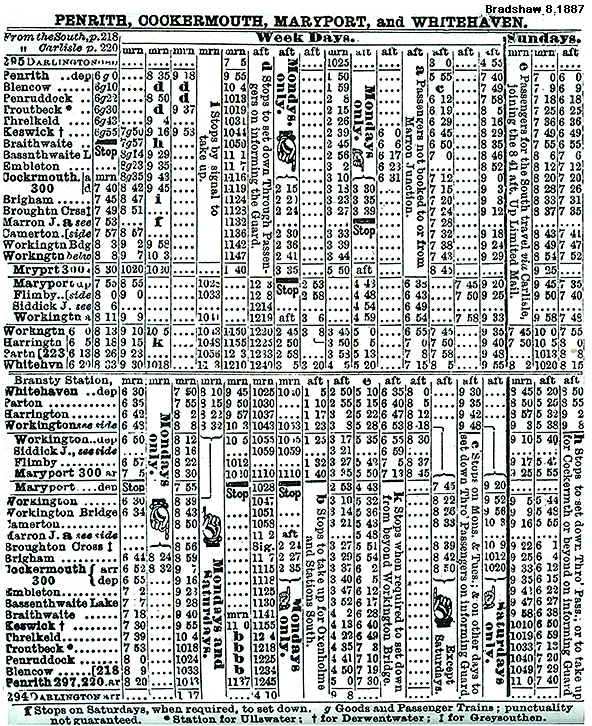
In April 2019 the derelict Bassenthwaite Lake station was bought by Cumbrian Railway Association members Simon and Diana Parums. The Parums have restored 10 historic properties over 30 years. They applied for planning permission from the Lake District National Park to turn the derelict station building into an accessible cafe and tourist attraction. They spent six months clearing the track and derelict buildings but quickly realised there was insufficient room in the old station itself to be a café. To accommodate the café they began looking for a carriage.
 They visited a specialist haulage yard in Stoke-on -Trent where there was a suitable carriage for sale. Sitting next to it was a steam locomotive, and for the Parums, it was an opportunity not to be missed. It was a full-scale replica of a world-famous locomotive used in the 2017 Hollywood adaptation of Agatha Christie's Murder on the Orient Express starring Johnny Depp and Dame Judy Dench. The replica was built in 12 weeks at Longcross Studios in Surrey by a dedicated team of engineers. They visited a specialist haulage yard in Stoke-on -Trent where there was a suitable carriage for sale. Sitting next to it was a steam locomotive, and for the Parums, it was an opportunity not to be missed. It was a full-scale replica of a world-famous locomotive used in the 2017 Hollywood adaptation of Agatha Christie's Murder on the Orient Express starring Johnny Depp and Dame Judy Dench. The replica was built in 12 weeks at Longcross Studios in Surrey by a dedicated team of engineers.
It is based upon the SNCF 241P class and the one glaring inaccuracy is the headlamp on the smokebox door. This was required for the film but the real 241P had the SNCF monogram in the centre of the smokebox door. The French classed their steam locos differently from most of the world. The 241 referred to 2 pony axles - 4 driving axles - 1 pony axle: what we and most of the world would call a 4-8-2. The 'P' signified a Passenger locomotive. The class remained in service until 1973.
The train was full of the props from the multi-million dollar movie, and the carriages are larger than normal to fit lighting and cameras inside.
Having purchased the replica locomotive and tender and a buffet car, salon and baggage carriage at a fraction of the cost of a real locomotive, a length of track was laid in the station and the locomotive and carriages were transported to Bassenthwaite Lake in December 2019. For now the station remains private and is not open to the public, and 24-hour security is in operation to prevent trespassing. The Parums are now living in the stationmaster's house. If everything goes according to plan, the café will be open by the end of 2020. In the future, the Parums would like to turn one of the carriages into a bird hide and they are exploring the idea of turning the station's cottage into an observatory. They are hoping that work on the site will be completed by the end of 2021.
Route map drawn by Alan Young. Tickets from Michael Stewart. Bradshaw from Alan Young.
To see the other
stations on the Cockermouth - Penrith line click on the station name: Cockermouth 1st, Cockermouth 2nd, Embleton, Braithwaite, Keswick, Briery Siding Halt, Threlkeld, Highgate Platform, Troutbeck, Penruddock & Blencow |

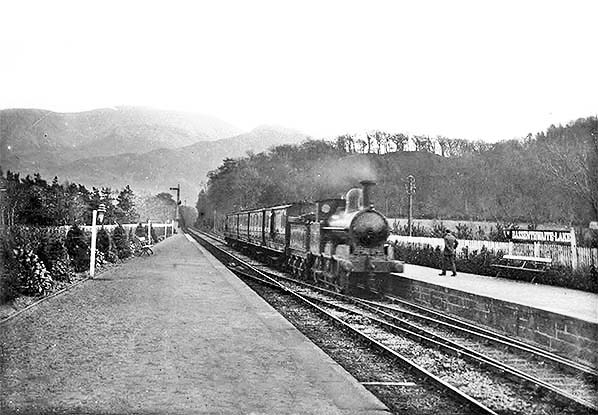

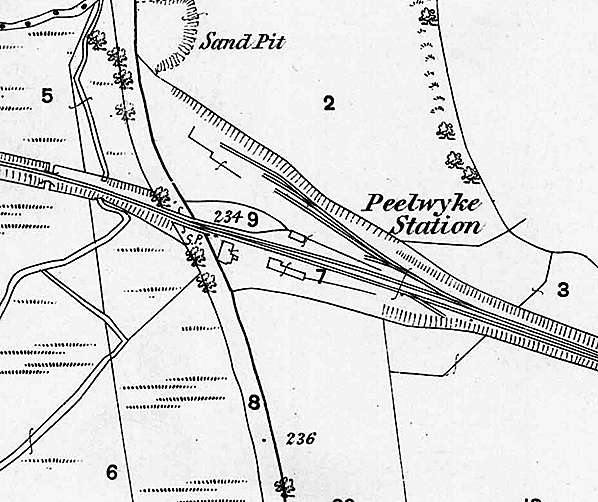

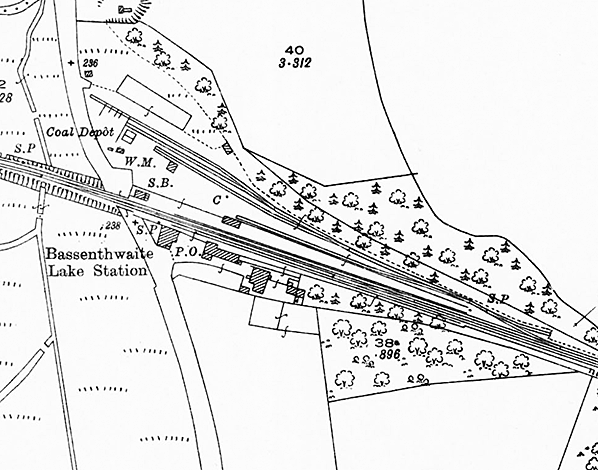
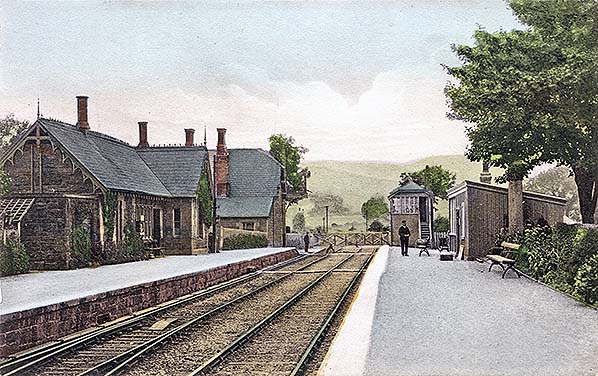
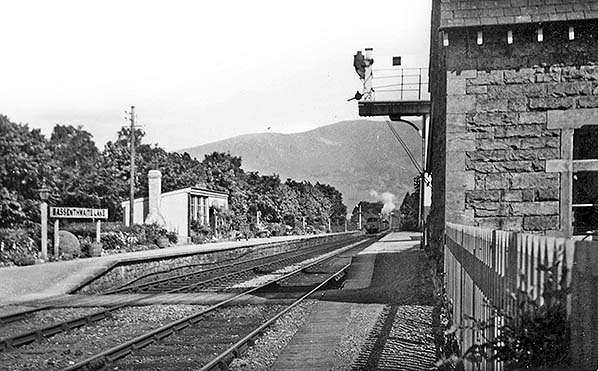
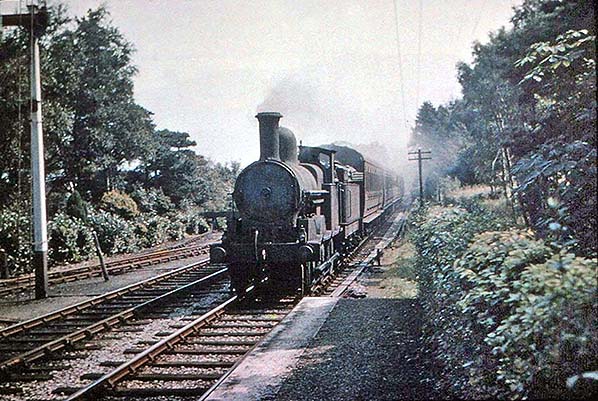


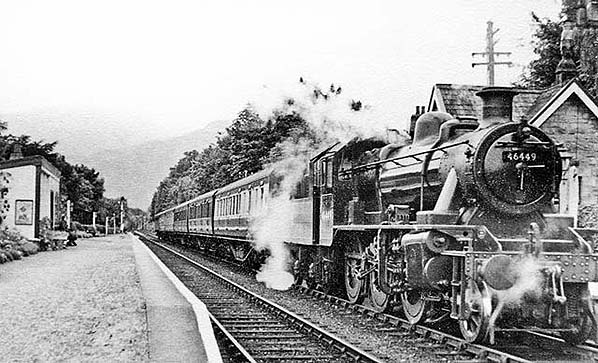

 Notes: The first official CK&P reference to a station near the northern end of Bassenthwaite Lake was in 1861 to be at the most convenient position where the railway passed Smithy Green. At a Works Committee meeting on 10 November 1862 it was decided that the site of the station and mineral depot would be on the north side of the line with a siding for timber on the south side, and that a level crossing, rather than bridge, should be provided for the line to cross the turnpike road if the trustees were content. In November 1863 the CK&P Works Committee opened tenders which had been invited for the construction of stationmasters’ houses, and this included a house at ‘Piel Wyke’ station; the earliest OS maps indicate that this was the name of a hamlet about ¼-mile south of the station. On 2 December 1863 the contract was awarded to Bolton & Graham to construct Piel Wyke stationmaster’s house for £333. A Board meeting on 4 May 1864 decided on names for the stations, and this one was to be known as Bassenthwaite Lake. It seems that the Ordnance Survey was not informed that the station was to be called Bassenthwaite Lake as it was named Peelwyke on the 1:2,500 map published close to the date of opening of the line and station in 1865. In later OS maps the hamlet was no longer named, only the Pheasant Inn within it. By the end of the century the maps showed the correct name of the station. Local people usually shortened the name to ‘Bass Lake’.
Notes: The first official CK&P reference to a station near the northern end of Bassenthwaite Lake was in 1861 to be at the most convenient position where the railway passed Smithy Green. At a Works Committee meeting on 10 November 1862 it was decided that the site of the station and mineral depot would be on the north side of the line with a siding for timber on the south side, and that a level crossing, rather than bridge, should be provided for the line to cross the turnpike road if the trustees were content. In November 1863 the CK&P Works Committee opened tenders which had been invited for the construction of stationmasters’ houses, and this included a house at ‘Piel Wyke’ station; the earliest OS maps indicate that this was the name of a hamlet about ¼-mile south of the station. On 2 December 1863 the contract was awarded to Bolton & Graham to construct Piel Wyke stationmaster’s house for £333. A Board meeting on 4 May 1864 decided on names for the stations, and this one was to be known as Bassenthwaite Lake. It seems that the Ordnance Survey was not informed that the station was to be called Bassenthwaite Lake as it was named Peelwyke on the 1:2,500 map published close to the date of opening of the line and station in 1865. In later OS maps the hamlet was no longer named, only the Pheasant Inn within it. By the end of the century the maps showed the correct name of the station. Local people usually shortened the name to ‘Bass Lake’.
 In 1910 the booking office section was extended south-westwards to provide space for a Post Office; the style of the extension was sympathetic to the existing building, of stone construction under a gabled slate roof. Later, the attractive bargeboards were replaced with plain ones and the cresting was removed. To the east of this building a pair of two-storey cottages under a half-hipped roof was erected sometime after the station opened to accommodate the two signalmen and their families; the cottages were of stone construction but were rendered, presumably at a later date. The handsome two-storey stone station house, also with half-hipped roof, stood to the west, close to the level crossing. By contrast the only structure on the up platform was an undistinguished pent-roofed timber shed with chimneystacks at each end serving the fireplaces in the waiting and porters’ rooms. In 1874 a signal box of brick and timber construction, under a hipped roof, opened west of the up platform, adjacent to the level crossing.
In 1910 the booking office section was extended south-westwards to provide space for a Post Office; the style of the extension was sympathetic to the existing building, of stone construction under a gabled slate roof. Later, the attractive bargeboards were replaced with plain ones and the cresting was removed. To the east of this building a pair of two-storey cottages under a half-hipped roof was erected sometime after the station opened to accommodate the two signalmen and their families; the cottages were of stone construction but were rendered, presumably at a later date. The handsome two-storey stone station house, also with half-hipped roof, stood to the west, close to the level crossing. By contrast the only structure on the up platform was an undistinguished pent-roofed timber shed with chimneystacks at each end serving the fireplaces in the waiting and porters’ rooms. In 1874 a signal box of brick and timber construction, under a hipped roof, opened west of the up platform, adjacent to the level crossing. It seems that from February 1910 the stationmaster took on the additional responsibility of Sub-Postmaster, although the 1900 OS map already identifies a Post Office in the building. As noted above, the station building was extended to accommodate this new function. The stationmaster from 1908-10 was John Blackburn and J W Ewart took on this role (as well as that of Sub-Postmaster) from 1910 until 1921.
It seems that from February 1910 the stationmaster took on the additional responsibility of Sub-Postmaster, although the 1900 OS map already identifies a Post Office in the building. As noted above, the station building was extended to accommodate this new function. The stationmaster from 1908-10 was John Blackburn and J W Ewart took on this role (as well as that of Sub-Postmaster) from 1910 until 1921. In January 1923 the station became part of the new London, Midland & Scottish Railway (LMS). At this time the stationmaster was Joseph Todhunter, who had been appointed in 1921. He held the post until 1933, and his successors were a Mr Grimley and Sam Whelan. The station changed little in LMS days, but it is thought that new nameboards were installed in this era. Camping coaches made their appearance, offering inexpensive accommodation for holidaymakers (who arrived and departed by train). Before 1939 the coaches were delivered to the station in spring and were removed for maintenance and storage in the winter. While they were in place at the station the siding upon which they stood was disconnected.
In January 1923 the station became part of the new London, Midland & Scottish Railway (LMS). At this time the stationmaster was Joseph Todhunter, who had been appointed in 1921. He held the post until 1933, and his successors were a Mr Grimley and Sam Whelan. The station changed little in LMS days, but it is thought that new nameboards were installed in this era. Camping coaches made their appearance, offering inexpensive accommodation for holidaymakers (who arrived and departed by train). Before 1939 the coaches were delivered to the station in spring and were removed for maintenance and storage in the winter. While they were in place at the station the siding upon which they stood was disconnected.  In January 1948 at nationalisation Bassenthwaite Lake station became part of the new British Railways (BR) London Midland Region (LM). Some rationalisation of the goods yard took place in 1951 when two of the sidings were removed. The former CK&P saw the introduction of diesel multiple units in early January 1955 which gradually replaced steam-hauled passenger trains. In the summer 1956 timetable (below) Sunday trains were introduced; they did not serve all intermediate stations but did call at Bassenthwaite Lake.
In January 1948 at nationalisation Bassenthwaite Lake station became part of the new British Railways (BR) London Midland Region (LM). Some rationalisation of the goods yard took place in 1951 when two of the sidings were removed. The former CK&P saw the introduction of diesel multiple units in early January 1955 which gradually replaced steam-hauled passenger trains. In the summer 1956 timetable (below) Sunday trains were introduced; they did not serve all intermediate stations but did call at Bassenthwaite Lake. In BR ownership Bassenthwaite Lake station continued to be staffed and photographs indicate that it remained well cared for and the tradition of maintaining an attractive garden continued. Camping coaches provided accommodation at the station into the 1960s. Along with most stations on the Workington – Penrith line, Bassenthwaite Lake was fitted with BR(LM) maroon vitreous enamel nameboards and totem lamp tablets, probably in the late 1950s. Although the station had been gas-lit the lanterns in use by the late 1950s/early 1960s held oil lamps as the gas equipment had worn out.
In BR ownership Bassenthwaite Lake station continued to be staffed and photographs indicate that it remained well cared for and the tradition of maintaining an attractive garden continued. Camping coaches provided accommodation at the station into the 1960s. Along with most stations on the Workington – Penrith line, Bassenthwaite Lake was fitted with BR(LM) maroon vitreous enamel nameboards and totem lamp tablets, probably in the late 1950s. Although the station had been gas-lit the lanterns in use by the late 1950s/early 1960s held oil lamps as the gas equipment had worn out.  A proposal to withdraw all passenger services was published on 5 July 1963 and followed the usual TUCC procedure. In late December 1966 Barbara Castle became Minister of Transport and one of her early decisions, announced on 10 January 1966, was that the route should be closed between Workington and Keswick but the remainder of the line to Penrith should be retained in view of the hardship which would be suffered by users of that section of the route. It seems ironic that Mrs Castle, herself at one time a keen rambler, should have refused closure of some Hope Valley (Derbyshire) stations so that ramblers could use them, whilst approving the closure of Bassenthwaite Lake and Braithwaite stations and the exceptionally scenic stretch of railway between them. The last trains ran between Workington and Keswick on 16 April 1966 and on 18 April Bassenthwaite Lake station closed. Below is the final list of train departures.
A proposal to withdraw all passenger services was published on 5 July 1963 and followed the usual TUCC procedure. In late December 1966 Barbara Castle became Minister of Transport and one of her early decisions, announced on 10 January 1966, was that the route should be closed between Workington and Keswick but the remainder of the line to Penrith should be retained in view of the hardship which would be suffered by users of that section of the route. It seems ironic that Mrs Castle, herself at one time a keen rambler, should have refused closure of some Hope Valley (Derbyshire) stations so that ramblers could use them, whilst approving the closure of Bassenthwaite Lake and Braithwaite stations and the exceptionally scenic stretch of railway between them. The last trains ran between Workington and Keswick on 16 April 1966 and on 18 April Bassenthwaite Lake station closed. Below is the final list of train departures.
 They visited a specialist haulage yard in Stoke-on -Trent where there was a suitable carriage for sale. Sitting next to it was a steam locomotive, and for the Parums, it was an opportunity not to be missed. It was a full-scale replica of a world-famous locomotive used in the 2017 Hollywood adaptation of Agatha Christie's Murder on the Orient Express starring Johnny Depp and Dame Judy Dench. The replica was built in 12 weeks at Longcross Studios in Surrey by a dedicated team of engineers.
They visited a specialist haulage yard in Stoke-on -Trent where there was a suitable carriage for sale. Sitting next to it was a steam locomotive, and for the Parums, it was an opportunity not to be missed. It was a full-scale replica of a world-famous locomotive used in the 2017 Hollywood adaptation of Agatha Christie's Murder on the Orient Express starring Johnny Depp and Dame Judy Dench. The replica was built in 12 weeks at Longcross Studios in Surrey by a dedicated team of engineers.
 Home Page
Home Page